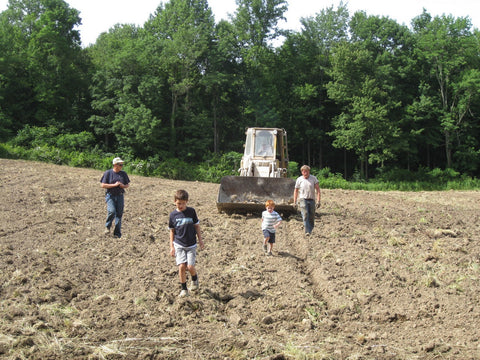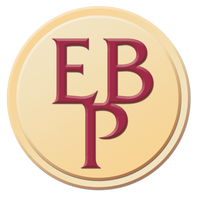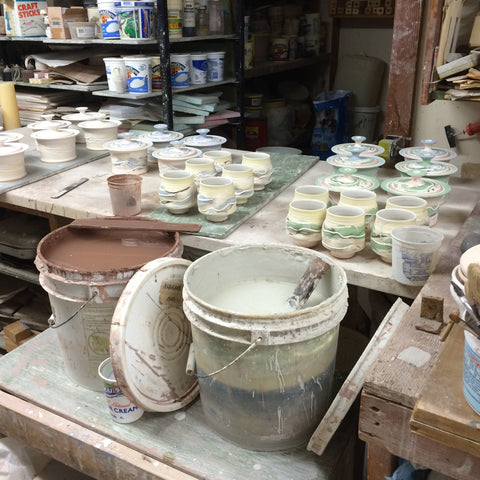Making Enough Pottery for the Season and Preparing the Soil for Planting in Door County
John loads up the glazing table with cups and covered dishes for me. These are two of our most popular glazes.
There was a time, years and years ago, when Ephraim was our family's vacation destination. Then my folks bought a hotel in Ephraim and I started cleaning bathrooms. I got summer jobs in the tourism industry, mostly housekeeping and dish-washing and as a server. I went to college and finally married and moved to Baileys Harbor to become a ------ dairy farmer/dairy farmer's wife. Yeah. How did that happen?
Years after that, once I sold the cows and machinery, I moved myself and my four children to Ellison Bay and married a potter. It didn't take long before I noticed that the seasonality of my previous dairy life was similar to our studio and gallery life.
On the farm in Baileys Harbor, the job I hated the most was picking stones in fields, preparing them for planting. Hate is a strong word, I understand that. But it doesn't even get close to how much I loathed that job.
Door County's soil is mostly rock with a little dirt thrown in. If you've gardened here you'd be nodding in agreement. Look around as you drive through the county and you'll see those cute rock fences. Those were made by farm families every spring. Parents and children, and if they could afford it a hired man, would walk out or ride the bucket attached to the front of a tractor, to the first field to be cleared of stones. A seed planter can be damaged by rocks and stones in the field, so this was a very important, never ending, chore. Winter with it's freezing and thawing heaved new rocks and stones up from the core of the earth to make my life a living hell each spring.
In small fields we'd fill up the bucket on the tractor and Dave (my first husband) would then drive it over to the rock fence that seemed a little thin and drop those rocks. With larger fields, we'd pull an old manure spreader into the field and fill that up. We'd each carry a white plastic five gallon bucket and fill it. Then walk over to the spreader. Dump. Repeat. Our two older kids shared the bucket and would help each other carry it to the spreader, but they needed Daddy to pick it up for them. They were probably better at picking rocks than I was because I was so crabby about having to do this task.
It was a cold, damp, dirty, hard job. But vital to our survival and success on the farm. We all worked together as a family, something that built a strength in our family.
When I moved my family to Ellison Bay, it wasn't obvious to me just how much my life on the farm, with it's cyclical nature, would have prepared me to life in the tourism industry. Farms had better months for milk production and pottery galleries have better months for pottery production and income generating.
The seasons corresponded as well. January milk production would drop based on the fertility of our cows and, as everyone knows, Door County is totally closed after Christmas. (That's a joke by the way. It's people's perception that everything is closed so they don't come up and then businesses have to close for the winter because no one comes up; that's the Circle of Life--cue the music).
What we did on the farm in the winter was maintain and repair machinery. We deep cleaned the milk house and updated records. Researched how to get a better yield with better seeds and how to improve the genetics of our cow's offspring and keeping our cattle healthy consumed us and increase milk production. I'd spring clean the house in the winter so in the spring I could be outside picking those damned rocks.
In the studio we learn what pottery sold the best last year, what glazes were most popular, what new items we've been thinking about should be made. We create plans for events, for inventory building, for maintenance and repair inside and outside of the gallery. Paperwork. Improvements in the business, advertising to try and to drop. And we make pottery, lots of pottery, so that our shelves are full when we open the doors in May, or April, or whenever people start driving down the driveway a lot and we put up the open sign for good.
Building an inventory can feel not so arty and more like a business, yet we have to think of what we do as a combination of creativity and taking creative risks and practical pragmatic decisions and jobs that must be done. In order to keep our creative muscles strong we give ourselves some time each day to play with clay, to experiment with textures, or shapes or watch a YouTube video on a different way to fabricate a box or mug. There are jobs that are not so cool such as recycling scraps of clay using the pug mill, with smells really bad and is loud. That's John's job. Keeping the inventory straight is mine. All of these little things combined plus commitment to going to the studio and working every day is both ordinary and extraordinary.
I mentioned the job I hated on the farm was picking stones. One of the reasons was that there are so many sizes, from grapefruit sizes to Cadbury Egg size and smaller. We had to have a limit or it would have taken days to clear one field of all stones and rocks. But there was an upside. Sometimes I would find pink quartz. Sometimes I'd find granite rocks. Sometimes I would find amazing fossils. If I could get over my disgust with this essential job I could get into the treasure hunting excitement that even my kids, who were under 10, had. Learning about the geology of Door County became a passion of mine. I've always collected rocks and stones and they moved with me for over 40 years. I remember where I got each one. My Mom collected stones and rocks, as did my maternal Grandmother and they kept those collections close, like lining up the precious stones on the window sill in front of the kitchen sink overlooking the garden they came from.
Then one day I meet a potter and begin learning a completely different aspect of stones. Of granite. Learning where clay comes from. How it's created, by the earth, over millions and millions of years. How we can transform this sticky plastic material into a kind of stone when we fired it just to it's melting point.
I miss so much of my previous farming life: working with my children in the barn or field. Dealing with my 'girls' in the barn and out in the field. Fetching my 'girls' in the pasture at 4:00 am every morning and seeing shooting stars and amazing northern lights. Slipping into the barn at 10:00 pm to give them one more slice of hay.
Then I think of how I, right after dinner, slip into the studio to cover up some project I've been working on, watch John at the wheel, sketch my ideas everywhere, write, meet people who fall in love with John's work, greet returning customers. I get to create a display in the gallery. We get to have a picnic on our porch for lunch every day during the busy season.

I didn't take photos when we were picking stones in the 80's so I've borrowed this one from a dairy mom in Ohio. I had no idea Ohio had rocks in it's fields as well.



Comments on this post (0)